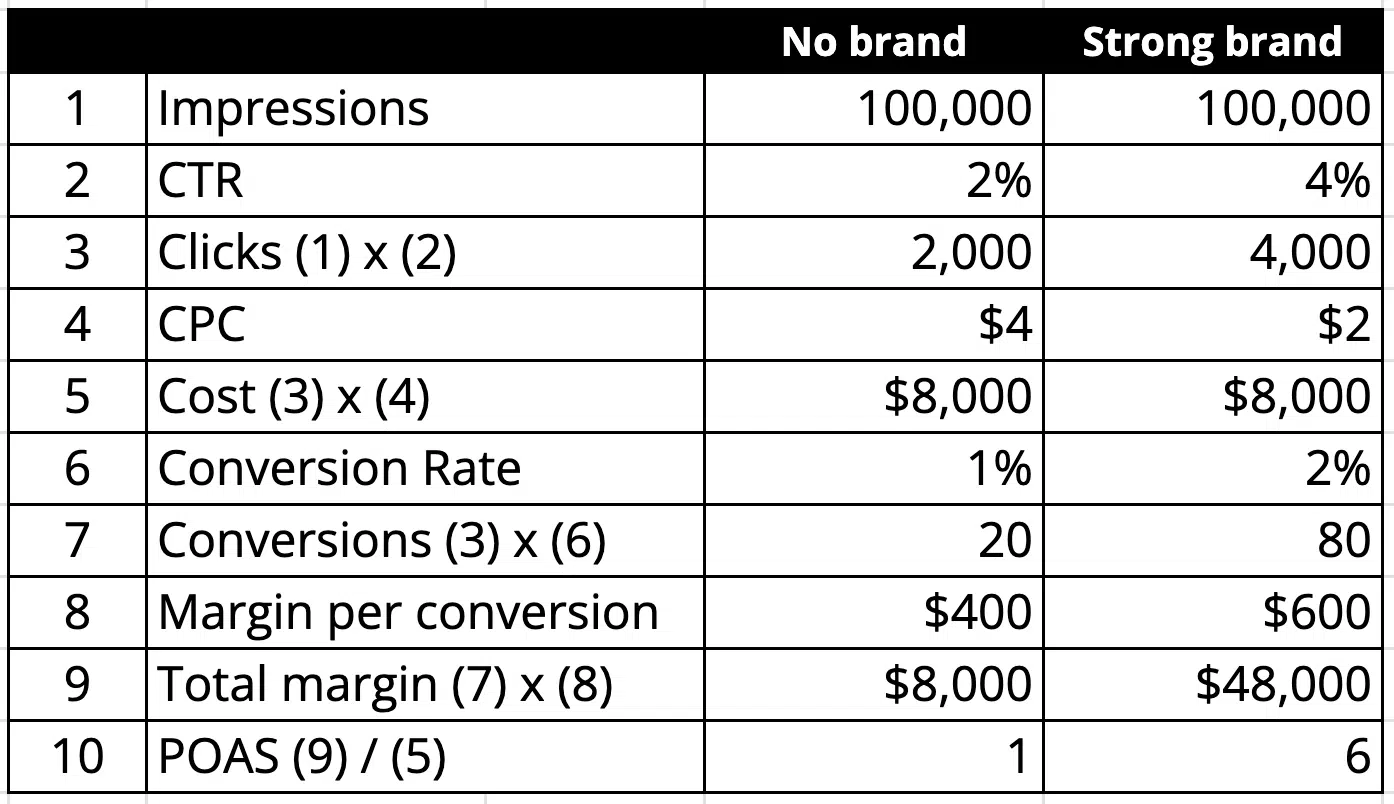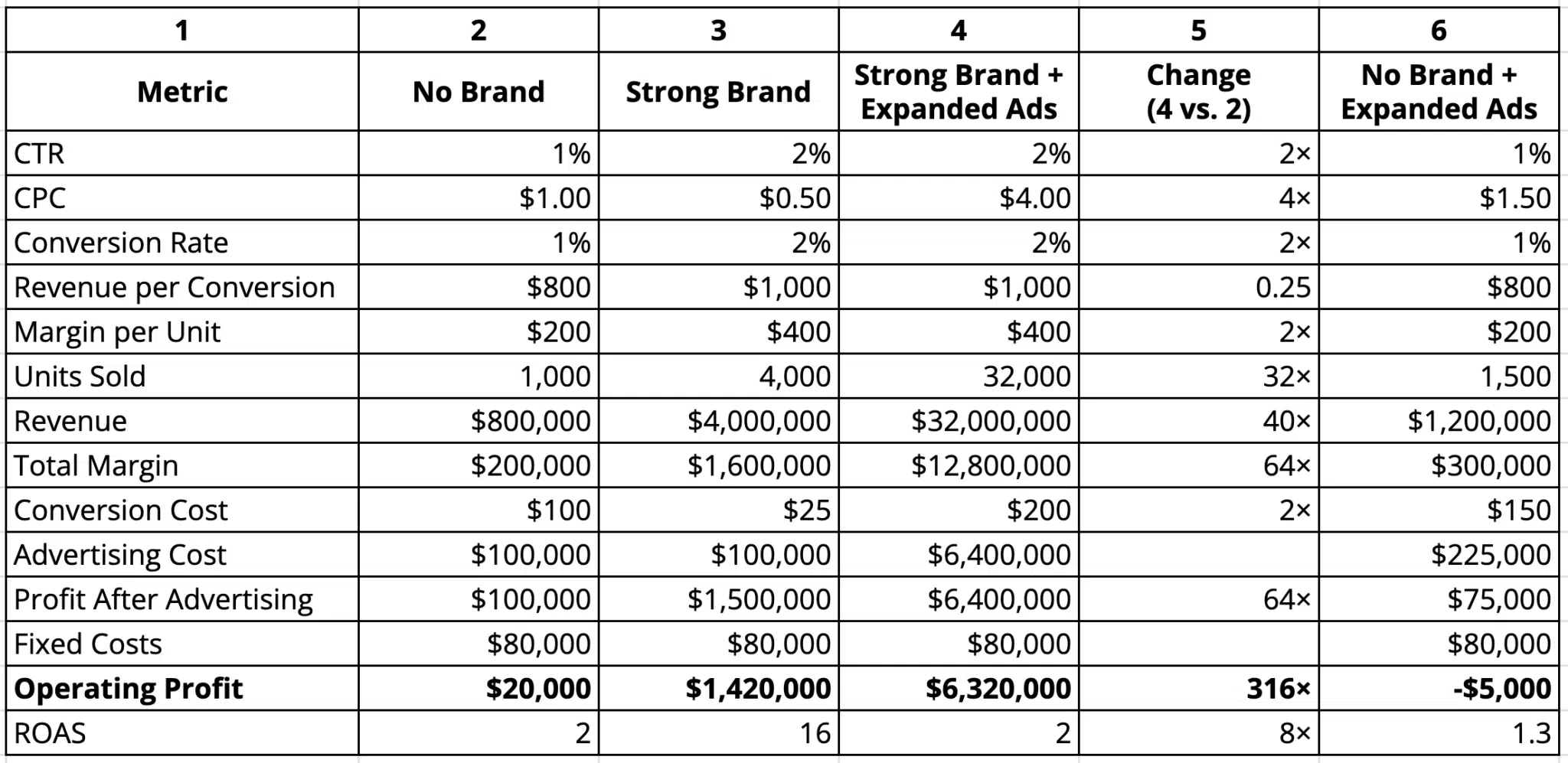Brand + performance: The secret to maximizing ad ROI
Performance marketing thrives on brand awareness. Learn how a strong brand enhances CTR, CPC, conversion rates, and overall profitability.
In digital marketing, a common belief is that everything can be measured – clicks, conversions, and ROI.
Many advertisers assume that brand awareness is unnecessary and that performance marketing alone is enough to drive sales.
After all, brand awareness campaigns don’t always generate immediate traffic or conversions visible in analytics.
Their effects unfold over time, making them harder to measure than performance-driven campaigns.
However, this overlooks a critical factor: brand strength acts as a multiplier for performance marketing effectiveness.
A well-known brand increases ad click-through rates (CTR), lowers cost-per-click (CPC), improves conversion rates, and ultimately boosts profitability.
This article explores:
- How a recognizable brand enhances performance marketing results.
- Why brand awareness allows businesses to sell more at higher margins.
- How multiple marketing levers work together to drive business growth.
- Why neglecting brand investment can limit long-term success.
By the end, you’ll see why strong branding isn’t just a “nice-to-have” – it’s a key driver of marketing efficiency and profitability.
Higher brand awareness means a higher CTR
Users are more likely to click on ads from well-known brands that evoke positive associations.
This idea is widely discussed in marketing, though reliable studies directly proving it are scarce.
However, several observations support this claim.
For example, remarketing campaigns using search ads often show higher CTRs for returning users.
While it’s difficult to isolate brand awareness as the sole factor – since market competition and other variables also play a role – user behavior analysis provides indirect evidence.
A reliable randomized controlled trial (RCT) in this context would be nearly impossible to conduct.
Even if some users click on ads without much thought (e.g., on social media), many base their decisions on the ad content and the destination URL.
For search ads, a significant portion of users consider the displayed destination URL.
I conducted a small survey (142 respondents, not representative) and found that 86% of users pay attention to the website URL before clicking on a Google search result.
This suggests that well-known brands tend to achieve higher CTRs in paid search.
Higher CTR means lower CPC
In the Google Ads ecosystem, advertisers don’t pay a fixed rate for clicks.
Instead, Google’s auction system considers Quality Score, where a higher score results in a lower CPC.
Since CTR is a key factor in Quality Score, ads with higher click-through rates typically benefit from lower CPCs.
Why does this happen?
From Google’s perspective, revenue remains the same whether 1,000 impressions generate 200 clicks at $1 each or 100 clicks at $2 each – both total $200.
Therefore, an ad with double the CTR can achieve half the CPC.
While CTR is crucial, other Quality Score factors – such as landing page experience – also play a role, further favoring strong brands.
Dig deeper: How to make your Google Ads brand campaigns more efficient
Higher brand awareness means a higher conversion rate
Numerous studies confirm that brand awareness positively impacts conversion rates.
A well-known brand reduces consumer hesitation by reinforcing trust in product quality and the seller’s reliability.
Strong brands attract loyal customers, enjoy a good reputation (including among experts), and create desirability – significantly increasing the likelihood of purchase compared to unrecognized alternatives.
Stronger brands achieve higher margins
Unlike lesser-known competitors, strong brands aren’t forced into price competition.
Customers trust their quality and reputation, making them willing to pay more.
This allows branded products to be sold at higher prices, increasing profit margins per unit.
Higher prices also accelerate margin growth.
For example, if a product costs $100 with a $20 margin, raising the price by 10% (to $110) increases the margin to $30 – a 50% increase in earnings per unit sold.
Higher CTR means greater sales
With a higher CTR, the same campaign delivers more traffic.
This leads to increased conversions and higher overall margins – driven by greater conversion values and a larger customer base.
Better CPC and CTR, conversion, and margin mean higher ROAS/POAS
Lower CPC, higher conversion rates, and increased conversion values all improve campaign profitability.
While each factor contributes individually, their combined effect is multiplicative rather than additive, significantly boosting overall efficiency.
For example, if CTR and conversion rates double and product margins increase by 50%, profit per sale grows sixfold (2 x 2 x 1.5 = 6).
If ad spend remains unchanged, the higher CTR (and the corresponding increase in clicks) is balanced by a proportional CPC reduction, resulting in a sixfold increase in (profit on ad spend) POAS.

Dig deeper: Branded keywords: How Google Ads drives up CPCs
Leverage effect: Higher profits through operational leverage
As sales increase, EBITDA (earnings before interest, taxes, depreciation, and amortization) and operational profits typically grow at an even higher rate.
This happens because fixed costs remain constant regardless of sales volume, making them less significant as revenue rises.
For example, consider a store with $30,000 in monthly sales margin (revenue less variable cost) and fixed costs of $20,000, resulting in a $10,000 profit.
If sales double, the sales margin also doubles to $60,000, and while fixed costs remain unchanged at $20,000, the profit increases to $40,000.
In this case, a twofold increase in sales leads to a fourfold increase in operational profit – an effect known as operational leverage.
Larger-scale advertising and even greater profits
As return on ad spend (ROAS) and profitability improve, companies can invest more in advertising – such as increasing PPC bids or expanding to new platforms.
Higher profits enable them to afford impressions and clicks at previously unprofitable prices, shifting the point of optimal profit and neutral marginal revenue to higher levels.
This advantage allows stronger brands to pay higher CPCs while remaining profitable, further expanding their market presence and pushing less reputable competitors’ ads to lower positions.
As a result, they achieve even greater sales volume, margins, and profits.
How does this translate to numbers?
A strong brand enhances performance marketing efficiency, enabling more aggressive media buying and driving significant revenue and profit growth.
But how significant?
Let’s analyze potential changes using sample data.
For a stronger brand, we assume:
- CTR doubles.
- Conversion rates double.
- Unit prices increase from $800 to $1,000, raising the margin per transaction from $200 to $400 (a twofold increase).
- Fixed costs remain $80,000 (10% of revenue for the “no-name” company).
The table below compares company revenue across three scenarios:
- Without a brand (column 2).
- With a strong brand (column 3).
- With a strong brand plus expanded advertising (column 4).

In this example, branding led to a fortyfold increase in revenue and a 316-fold increase in profit – largely driven by increased advertising investment.
However, as shown in the last column of the table, a company without a brand would incur operational losses if it attempted to scale performance marketing in the same way.
In contrast, a strong brand can afford aggressive marketing, pay significantly more for traffic, and still grow its profits.
The figures in the table were chosen for clarity.
Still, even smaller differences in efficiency between branded and non-branded products demonstrate how brand awareness:
- Amplifies revenue.
- Transforms a barely profitable or loss-making company into a highly profitable business.
If you’d like to test how different values affect the outcome, you can explore the simulation in this Google spreadsheet:
- https://docs.google.com/spreadsheets/d/13EQMW2eKGthIEmgoxXdCG7qyNGqMyzk7qLatmbVOLV0/edit?usp=sharing (Create a copy to modify values.)
A well-known brand generates direct traffic
The previous calculations don’t yet account for another key advantage of a strong brand – substantial direct traffic.
Brand awareness drives users to visit a website directly, either by typing its address into their browser or clicking on branded search results, whether organic or paid.
These visits typically convert at higher rates than traffic from marketing campaigns, as they come from users with strong intent.
As a result, direct traffic can generate significant revenue with little to no additional investment.
In the earlier example, assuming a 30% increase in sales from direct traffic, revenue would rise to $41.6 million and profit to $10.16 million – compared to just $20,000 for a company without a strong brand.
Investing in brand marketing pays off
The simulations clearly show that as a brand gains recognition and trust, a multiple-leverage effect emerges.
Higher CTRs, improved conversion rates, the ability to raise prices, and more aggressive advertising all drive profitability – further boosted by direct traffic from loyal customers.
A well-known brand also provides additional advantages, such as spontaneous media interest, easier press placements, and stronger negotiating power with suppliers and in the job market.
Brand growth comes with challenges, such as combating counterfeits and managing reputation risks – issues that lesser-known companies rarely face.
While the simulation assumes fixed costs remain unchanged, significant expansion would inevitably lead to higher expenses.
However, these added costs are far outweighed by the benefits.
Investing in brand awareness:
- Delivers measurable returns.
- Improves the efficiency of performance marketing.
- Unlocks growth opportunities unavailable to weaker brands.
That said, building a brand is more than just running ads (display, video, TV, outdoor, etc.).
It requires a cohesive, strategic approach rooted in audience insights, strong messaging, and creative execution.
Simply showing a “big logo” everywhere won’t build a brand – no matter how many times people see it.
DIg deeper: Why over-bidding on your brand could be hurting your bottom line
Contributing authors are invited to create content for Search Engine Land and are chosen for their expertise and contribution to the search community. Our contributors work under the oversight of the editorial staff and contributions are checked for quality and relevance to our readers. The opinions they express are their own.
Related stories
New on Search Engine Land